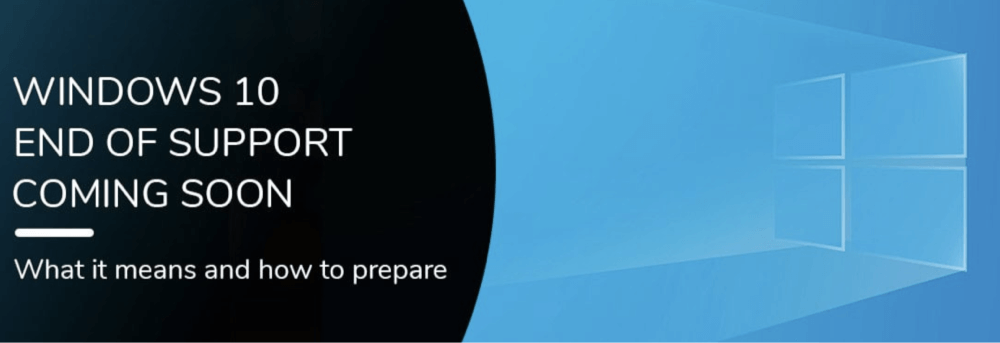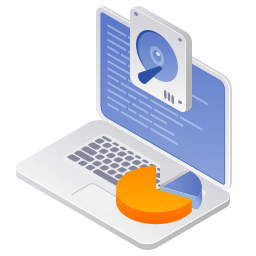PAGE CONTENT:
Microsoft officially announced the end of support for Windows 10 on October 14, 2025, marking the conclusion of a significant chapter in the company's operating system history. Launched in 2015, Windows 10 became one of the most widely used versions of Windows, powering everything from home PCs to enterprise servers.
As the end-of-support date approaches, users and businesses alike face important decisions. What does this change mean for you? Should you upgrade to Windows 11, switch to another OS, or continue using Windows 10? This article explains the implications and outlines all your available options, helping you plan the best way forward.

What Does "End of Support" Mean?
Microsoft's "end of support" for an operating system refers to the discontinuation of:
- Security updates
- Bug fixes
- Technical support
- Feature improvements
In simple terms, once support ends, your PC will no longer receive critical patches to protect against newly discovered vulnerabilities. While your machine will still function, it will become increasingly unsafe and potentially incompatible with newer applications or hardware.
This is similar to what happened with Windows 7, which reached end of support in January 2020. Many users delayed upgrades, but by mid-2021, most software vendors had also ceased support for Windows 7, leading to real-world usability and security issues.
Risks of Staying on Windows 10 After Support Ends
Continuing to use Windows 10 after October 2025 introduces several risks:
1. Security Vulnerabilities
Without security patches, your system becomes a prime target for malware, ransomware, phishing attacks, and zero-day exploits. Even strong antivirus software won't fully compensate for the lack of OS-level security updates.
2. Software and Driver Incompatibility
Many new applications and hardware drivers will stop supporting Windows 10. This could lead to issues running popular software like Adobe, Microsoft Office, or browsers like Chrome and Firefox.
3. Data Privacy and Compliance Issues
If you run a business, using an unsupported OS may violate regulatory frameworks like GDPR, HIPAA, or PCI-DSS. This can expose you to legal liabilities or failed audits.
4. No Technical Support
Microsoft and most third-party vendors will no longer provide help for issues on Windows 10. You'll be on your own in resolving system crashes or software problems.
Your Options Moving Forward
The good news is: you have multiple paths forward, depending on your needs and budget.
A. Upgrade to Windows 11
Upgrading to Windows 11 is the most direct and supported way to stay within the Microsoft ecosystem and continue receiving security updates, new features, and compatibility with modern applications.
Why Upgrade to Windows 11?
Windows 11 introduces a redesigned interface and system-level improvements aimed at modern hardware and user behavior. Key benefits include:
- Refreshed UI: Centered Start Menu, rounded corners, and Fluent Design elements offer a cleaner and more intuitive experience.
- Virtual Desktop Enhancements: You can now organize multiple desktops for different workflows more effectively.
- Snap Layouts & Snap Groups: These new window management tools make multitasking faster and more organized.
- DirectStorage: Designed for gamers, this feature drastically reduces load times by allowing games to access storage faster, provided you have an NVMe SSD.
- Improved Security: Windows 11 mandates hardware-level security with TPM 2.0 and Secure Boot, offering better resistance to firmware and boot-level attacks.
System Requirements for Windows 11:
- Compatible 64-bit processor (1 GHz or faster with 2+ cores)
- 4 GB RAM or more
- 64 GB storage
- TPM 2.0 enabled
- UEFI firmware with Secure Boot
You can check compatibility with Microsoft’s free PC Health Check Tool.
How to Upgrade:
- Back up your data using an external drive or cloud storage.
- Visit Settings > Update & Security > Windows Update and check for upgrade eligibility.
- Follow the on-screen instructions for the upgrade process.
Pros of Windows 11
- Better support for hybrid and touchscreen devices
- Built-in Microsoft Teams integration
- Enhanced gaming and DirectStorage capabilities
- Long-term support until at least 2031
Cons
- May not support older hardware
- Learning curve due to redesigned Start menu and taskbar
- Some legacy apps may behave unpredictably
If your PC doesn't meet Windows 11 requirements, read on for other options.
B. Buy a New PC with Windows 11 Pre-installed
If your current PC is too old for Windows 11, it may be more cost-effective to purchase a new device. Most new laptops and desktops come with Windows 11 out of the box and are optimized for performance and longevity.
When to consider buying a new PC:
- Your current device is 5+ years old
- Fails the Windows 11 compatibility check
- Upgrading internal hardware is too expensive or technically difficult
Before disposing of your old machine, consider:
- Donating it
- Installing a lightweight Linux OS
- Repurposing it as a media server or backup device
Make sure to wipe your data securely before recycling or donating.
C. Subscribe to Extended Security Updates (ESU) – For Businesses
For enterprise environments, Microsoft offers Extended Security Updates (ESUs) for a fee. This option is ideal for organizations that need more time to transition critical systems.
Key facts:
- Available only to Volume Licensing customers
- Offers security patches for up to three years beyond end of support
- Paid annually, with cost increasing each year
This is not a long-term solution, but it can give businesses breathing room to plan an upgrade strategy.
D. Switch to an Alternative Operating System
If you're open to trying something new and want to avoid Microsoft's upgrade path, you can switch to an alternative OS.
1. Linux (e.g., Ubuntu, Mint, Fedora)
- Free and open-source
- Great for tech-savvy users or those with older hardware
- Wide support for open-source software
Pros
- Fast and lightweight
- Less prone to viruses
- Highly customizable
Cons
- Steep learning curve
- Compatibility issues with certain apps or games
- Not ideal for users heavily dependent on Microsoft Office or Adobe tools
2. ChromeOS Flex
- Developed by Google for basic computing tasks
- Great for older PCs and educational use
Pros
- Easy to install and use
- Fast boot time
- Integrates well with Google services
Cons
- Limited offline functionality
- Doesn't support native Windows apps
How to Prepare for the Transition?
Regardless of the path you choose, preparation is key. Here are the steps to ensure a smooth transition:
1. Back Up Your Data
- Use cloud services like OneDrive or Google Drive
- Consider an external hard drive with backup software
- Verify the backup before making changes
2. Run a PC Health Check
- Microsoft's PC Health Check Tool evaluates your system for Windows 11
- Tools like Speccy or Belarc Advisor give detailed hardware reports
3. List Your Must-Have Apps
- Check if your favorite apps are compatible with Windows 11 or Linux
- Find alternatives if needed (e.g., LibreOffice for Microsoft Office)
4. Set a Timeline
- Don't wait until the last minute
- Home users should aim to upgrade by mid-2025
- Businesses should start transitions at least a year in advance
5. Educate Your Household or Team
- Share resources, tutorials, or conduct internal training
- Set clear dates for upgrade deadlines and backups
What Happens If You Do Nothing?
Yes, Windows 10 will still function after October 14, 2025. But here's what to expect:
- Increased risk: You'll be more exposed to malware and exploits.
- Diminishing support: Browsers, antivirus tools, and apps will eventually stop working.
- No help: Microsoft will decline support requests, even for paid users.
- Higher long-term cost: Emergency fixes or data recovery could outweigh the cost of upgrading.
If your system houses sensitive information or is used for financial, healthcare, or business tasks, staying on Windows 10 post-2025 is strongly discouraged.
FAQs About Windows 10 Support End
1. Can I keep using Windows 10 after support ends?
Yes, but it's highly risky due to lack of security patches and vendor support.
2. Is Windows 11 free for all users?
It's free for eligible Windows 10 devices. Otherwise, you may need to buy a license or a new device.
3. Will my files and programs transfer during an upgrade?
In most cases, yes. However, always back up files and check software compatibility beforehand.
4. What if my PC isn't compatible with Windows 11?
You can either buy a new PC, install an alternative OS, or use ESU if you're a business customer.
Conclusion
The end of support for Windows 10 in October 2025 is not the end of the world - but it is the end of safe, supported use. Whether you're an individual, a family, or an IT administrator, planning ahead is essential to avoid risk, data loss, or costly downtime.
You have multiple paths forward:
- Upgrade to Windows 11 if your PC supports it
- Buy a new, modern PC with Windows 11 pre-installed
- Explore Linux or ChromeOS for budget or technical flexibility
- If you run a business, use Microsoft’s Extended Security Updates as a temporary bridge
Start preparing today. Back up your data, check your system, and decide on the best path for your needs. Don't wait until support ends to act - by then, it may be too late.
💡 Tip: Donemax Disk Clone is a powerful disk cloning program. It can create full bootable backups for your PC before or after upgrading Windows 10 PC.

Donemax Disk Clone
An award-winning disk cloning program to help Windows users and Mac users clone HDD/SSD/external device. It also can create full bootable clone backup for Windows PCs and Macs.
Related Articles
- May 26, 2024How to Add Pictures for Mac Background?
- Nov 13, 2024About Apple Silicon M4 Chips: Everything You Should Know
- Jul 11, 2025How to Use an USB Drive on Mac?
- Jan 21, 2025HDD vs. SSD: A Detailed Comparison
- Jun 13, 2025macOS Tahoe 26: Everything You Should Know and Install it
- Oct 24, 2024Safari vs. Chrome on Mac: A Comprehensive Comparison

Steven
Steven has been a senior writer & editor of Donemax software since 2020. He's a super nerd and can't imagine the life without a computer. Over 6 years of experience of writing technical solutions and software tesing, he is passionate about providing solutions and tips for Windows and Mac users.

Gerhard Chou
In order to effectively solve the problems for our customers, every article and troubleshooting solution published on our website has been strictly tested and practiced. Our editors love researching and using computers and testing software, and are willing to help computer users with their problems
Hot Donemax Products

Clone hard drive with advanced clone technology or create bootable clone for Windows/Mac OS.

Completely and easily recover deleted, formatted, hidden or lost files from hard drive and external storage device.

Certified data erasure software - permanently erase data before selling or donating your disk or any digital device.